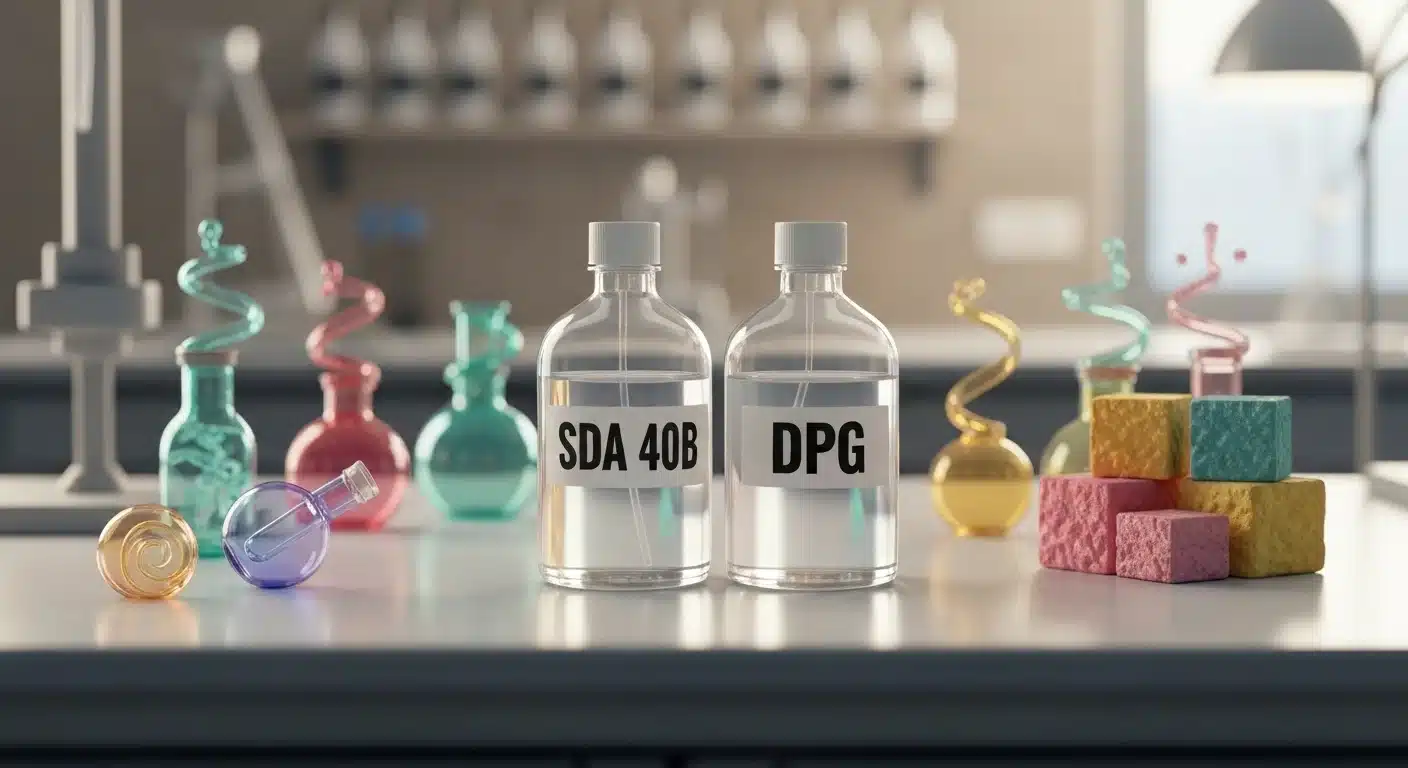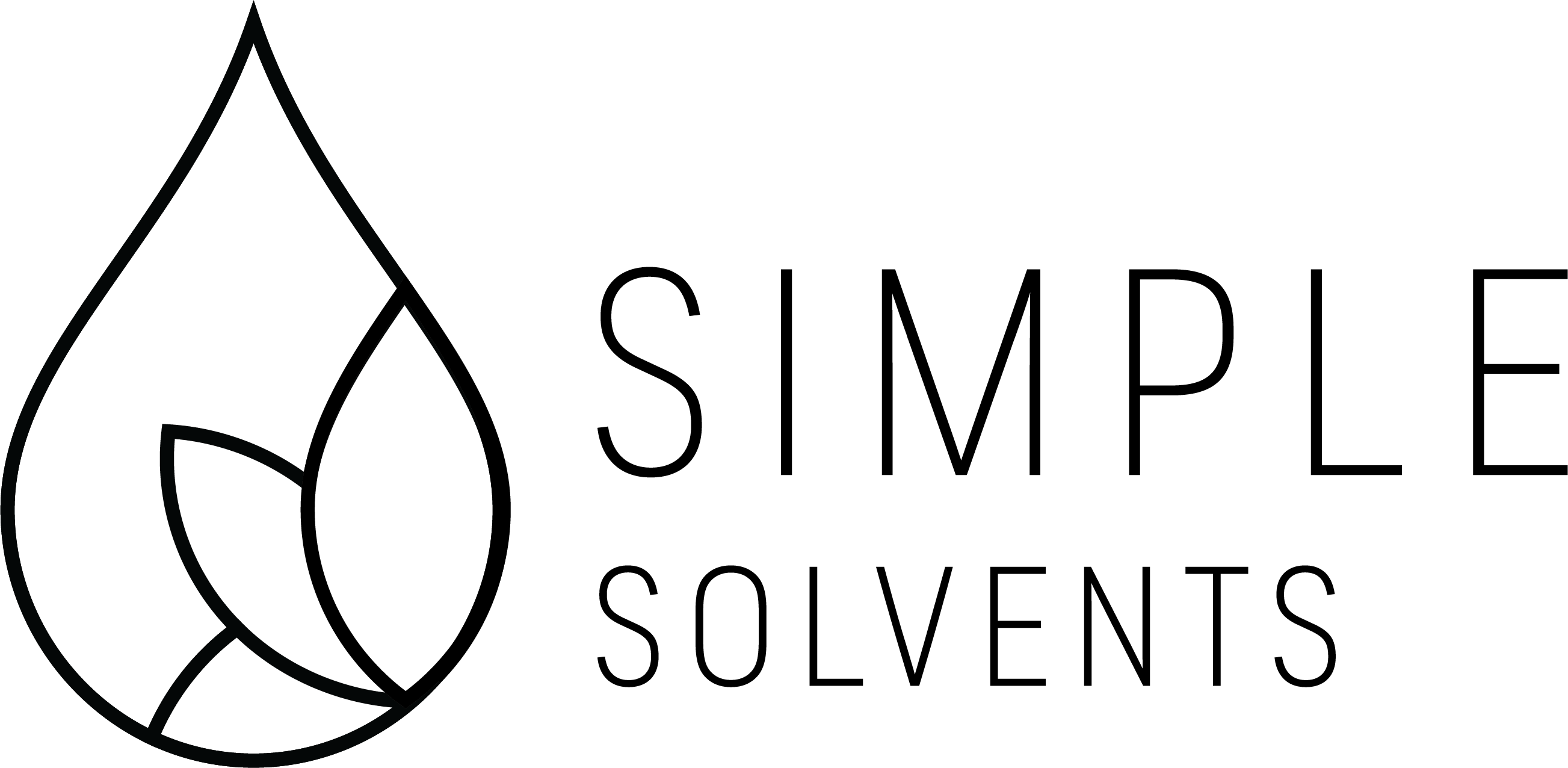SDA 40B & DPG: Essential Ingredients in Fragrance Formulation

Behind every beautifully crafted perfume, cologne, or room spray lies a complex blend of science and artistry. While fragrance oils capture attention with their distinctive scents, it’s the carriers and solvents that make these aromas wearable, stable, and long-lasting. Among the most essential of these are SDA 40B alcohol and dipropylene glycol (DPG).
Both play critical but different roles: SDA 40B acts as the evaporative carrier that lifts fragrance molecules into the air, while DPG ensures even distribution and consistency. Together, they are the backbone of modern fragrance formulation, influencing everything from texture and clarity to scent longevity.
This guide explores what makes SDA 40B and DPG for perfume indispensable ingredients, their unique characteristics, and how they work together to create exceptional fragrance experiences.
Understanding SDA 40B Alcohol
What Is SDA 40B?
SDA 40B, or Specially Denatured Alcohol 40B, is a high-purity form of ethanol (ethyl alcohol) that has been blended with specific denaturants, usually t-butyl alcohol and denatonium benzoate to make it unsuitable for consumption but perfectly safe for cosmetic and industrial use.
This formulation is approved and regulated by the U.S. Alcohol and Tobacco Tax and Trade Bureau (TTB), making it compliant for use in products like perfumes, body sprays, aftershaves, and other alcohol-based cosmetics.
Key Properties of SDA 40B Alcohol
- High purity (95–96% ethanol) ensures clarity and a neutral scent profile.
- Fast evaporation helps fragrance molecules diffuse smoothly into the air.
- Non-greasy feel leaves skin and fabrics residue-free.
- Safe for skin contact when used according to cosmetic regulations.
- Regulatory compliance simplifies shipping, labeling, and manufacturing for fragrance producers.
SDA 40B in Perfumes & Colognes
In perfume and cologne formulations, SDA 40B serves as the volatile carrier, it dissolves fragrance oils, then evaporates to release their aroma. The quick evaporation of ethanol allows top notes to emerge first, followed by heart and base notes, creating the multi-layered scent experience that defines a well-crafted fragrance.
The result is a clean, consistent formula that feels weightless on the skin and delivers reliable scent projection.
The Compliance & Quality Edge of SDA 40B
One of SDA 40B’s greatest advantages is its regulatory compliance. Because it’s denatured with approved additives, it meets all federal standards for cosmetic and industrial ethanol. Manufacturers using SDA 40B can avoid the taxes associated with beverage-grade alcohol while still producing a safe and high-performing cosmetic product.
Additionally, reputable suppliers such as Simple Solvents provide lab-tested SDA 40B alcohol with Certificates of Analysis (COAs), ensuring batch-to-batch consistency and purity. This transparency is vital for fragrance manufacturers who need reliable ingredients for large-scale or repeat production runs.
Introducing Dipropylene Glycol (DPG)
What Is DPG?
Dipropylene glycol (DPG) is a colorless, nearly odorless, and moderately viscous liquid often used as a solvent and carrier in fragrance, cosmetic, and industrial applications. Unlike ethanol, which evaporates quickly, DPG has a low volatility, meaning it helps anchor and stabilize fragrance oils.
Chemically, DPG is part of the glycol family, organic compounds known for their ability to mix with both water and oils. This property makes it a highly versatile ingredient in perfumes, lotions, and diffusers.
Key Properties of DPG
- Low evaporation rate, providing lasting scent retention.
- Excellent solubility for essential oils and aroma compounds.
- Neutral odor, ensuring it doesn’t interfere with fragrance notes.
- Non-flammable and non-irritating, enhancing formulation safety.
- Smooth texture, ideal for skin-friendly applications.
DPG for Perfume: Why It Matters
In fragrance formulation, DPG for perfume is valued for its ability to balance performance and longevity. It acts as a fixative and stabilizer, ensuring that aromatic compounds remain evenly distributed throughout the blend.
When mixed with ethanol or other solvents, DPG slows down the evaporation rate of certain fragrance molecules, enhancing scent persistence on the skin or in the air. This makes it a particularly useful ingredient in:
- Perfumes and body mists, to extend fragrance life.
- Reed diffusers, to regulate scent release.
- Room sprays, for controlled diffusion and surface safety.
- Lotions and creams, to help oil-based fragrances integrate smoothly.
SDA 40B vs. DPG: Understanding Their Roles
Although both SDA 40B and DPG are solvents, they serve different but complementary functions in fragrance formulation:
| Property | SDA 40B Alcohol | Dipropylene Glycol (DPG) |
| Volatility | High – evaporates quickly | Low – evaporates slowly |
| Function | Primary carrier; disperses fragrance oils | Fixative and stabilizer |
| Texture | Thin, water-like | Smooth, slightly viscous |
| Odor | Neutral, faint alcohol scent | Odorless |
| Use Cases | Perfumes, colognes, body sprays, room sprays | Perfumes, diffusers, lotions |
| Effect on Fragrance | Helps release top and heart notes | Prolongs base notes and overall longevity |
In short: SDA 40B provides the lift, while DPG provides the longevity. Together, they ensure a fragrance performs beautifully from the first spritz to the final lingering note.
Using SDA 40B and DPG Together
Professional perfumers and manufacturers often use a blend of SDA 40B and DPG to optimize performance. Here’s how they complement each other:
- Dissolution and dispersion: SDA 40B dissolves the fragrance oils completely, ensuring a uniform mixture. DPG keeps heavier components stable and evenly distributed.
- Evaporation control: The combination helps modulate how quickly or slowly different notes appear.
- Texture and clarity: Ethanol ensures a clear, bright finish, while DPG adds smoothness and skin feel.
- Extended shelf life: DPG’s stabilizing nature prevents separation or degradation over time.
Formulators often experiment with different ratios of ethanol to DPG, depending on the intended application, a perfume, room spray, diffuser, or lotion will each require a different balance.
Handling and Safety Considerations
Both SDA 40B and DPG are safe when handled correctly and used within cosmetic guidelines. However, each has specific precautions:
- SDA 40B: Highly flammable; store in tightly sealed containers away from heat or open flames. Use in well-ventilated areas.
- DPG: Low toxicity but can irritate skin in high concentrations. Handle with gloves and safety glasses.
Always consult your Safety Data Sheets (SDS) and follow OSHA and TTB guidelines when manufacturing or blending fragrances.
The Importance of Quality and Consistency
Because both solvents directly affect fragrance performance, sourcing them from a reliable supplier is critical. Impurities or inconsistencies in ethanol or glycol quality can alter scent clarity, stability, and safety.
Simple Solvents provides lab-tested SDA 40B alcohol and high-purity DPG with full traceability, ensuring consistent results for perfumers, cosmetic brands, and industrial fragrance producers. Each product is supported with COAs and shipped nationwide in secure, compliant packaging.
Conclusion
Whether you’re developing a luxury perfume, a refreshing body mist, or a long-lasting diffuser oil, SDA 40B alcohol and dipropylene glycol are essential ingredients for achieving performance, compliance, and balance in your formulations.
SDA 40B delivers fast-drying clarity and fragrance projection, while DPG provides stability, smoothness, and longevity. Together, they form the perfect partnership for professional fragrance creation.
At Simple Solvents, we supply premium, wholesale SDA 40B and DPG trusted by fragrance manufacturers nationwide. Each batch is lab-tested and backed by a Certificate of Analysis to ensure quality, consistency, and safety.
Ready to elevate your fragrance formulations? Request a Quote today or explore our Wholesale Ethanol & Glycol Solutions.
